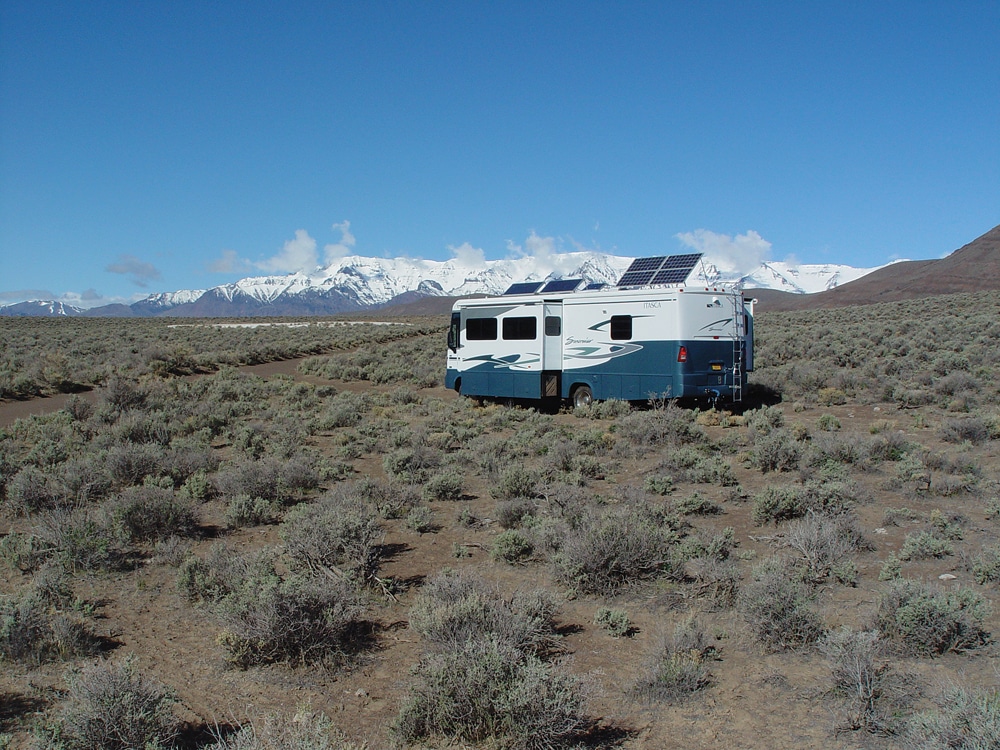Going without hookups is not for everyone. But, for motorhomers who like the idea of getting off the beaten path, it’s a way to occasionally or frequently expand our horizons. Full self-containment capability is built into virtually all motorhomes, with such items as auxiliary (house) batteries, fresh-water storage, separate gray-water and waste holding tanks, LP-gas storage and AC generators. This equipment gets little use unless we dry camp, also known as boondocking.
 Dry-camping sites vary greatly, including such destinations as a remote spot in the desert, a side yard at a friend’s home, a stream-side location on public lands, a sporting event, a casino and even a hospital parking lot. (Many hospitals allow motorhomes overnight in their parking lots while the owners are visiting patients.) If you haven’t stretched the limits of your coach, you may be surprised at how well it performs.
Dry-camping sites vary greatly, including such destinations as a remote spot in the desert, a side yard at a friend’s home, a stream-side location on public lands, a sporting event, a casino and even a hospital parking lot. (Many hospitals allow motorhomes overnight in their parking lots while the owners are visiting patients.) If you haven’t stretched the limits of your coach, you may be surprised at how well it performs.
For dry camping, a motorhome should offer reliable ways to measure how much of its resources have been used: gauges for battery reserve power, water, holding tanks and the LP-gas tank.
When not connected to shorepower, we either run an AC generator for battery recharging (and other functions) or we rely on batteries. Many motorhomes do not include accurate voltmeters, which we need for monitoring battery state of charge.
 Voltage State of Charge
Voltage State of Charge
12.6 or higher 100%
12.4 70%
12.1 50%
11.8 30%
11.5 10%
These readings refer to batteries that are at rest (no load). Always measure voltage the same way. A voltmeter that monitors solar panels is a good indicator, as is the Voltminder, which is readable at a glance. A good hand-held multimeter will suffice, but is less convenient.
Consider your batteries depleted when voltage drops to 11.8. It’s best to perform a recharge when voltage drops to 12.1 (50 percent). While you can recharge batteries via the AC generator (operating your electrical converter/battery charger), most factory converter/chargers do not provide effective battery recharging. Using an aftermarket unit like the Xantrex Truecharge will provide more efficient and complete charging through multistage circuitry.
Solar panels are popular with the boondocking crowd and some owners rely on the engine alternator for recharging while on the road, although that’s not very practical when parked in one place for more than a couple of days. Good battery capacity (at least 220 amp hours) is needed.
Adequate water storage capacity is essential, and the definition of adequate is subject to personal water conservation skills. Capacity of at least 70 gallons is needed unless dry-camp duration is only two or three days.
It’s not very convenient, but if necessary for extended stays it may be possible to bring water to your site. Locate a water source (gas station, town park, etc.) while exploring in your dinghy, and fill a couple of collapsible 5-gallon water containers. Pour the water into your motorhome’s gravity fill, or pump it in via the city water connection point:
1. Set your winterization valve to “winterize.”
2. Set the water intake valve to the tank “fill” position.
3. Insert the winterization tube into the water container.
4. Turn on the water pump, which usually will transfer an external water supply into the motorhome’s tank. Or, consideracquiring an extra RV water pump for use as a portable.
Ideally, your gray-water tank should be larger than the fresh-water capacity. The black tank usually is the last to fill. Upon exiting your no-hookups situation you’ll probably be looking for a dump station. Listings can be found in campground directories, at www.sanidumps.com and by searching the Internet.
Locating sites for unplugged adventures in your coach usually requires exploration in your dinghy to make sure the site is what you envisioned, and that the road leading to it is manageable. Also evaluate the area from the standpoint of security.
We have found some of our most interesting and visually spectacular motorhoming experiences this way, usually on public lands in dispersed-camping areas or in primitive campgrounds. And we’re often in the company of like-minded RV travelers.

